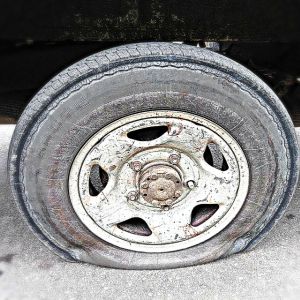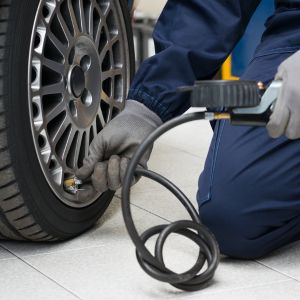A punctured tyre occurs when a sharp object, such as a nail or piece of glass, penetrates the rubber of the tyre and creates a hole. This can cause the tyre to lose air, resulting in a flat or under-inflated tyre. Punctures can happen at any time, and they can be dangerous because they can cause a loss of control while driving. Now, we’ll explore a range of practical tips, tools, and techniques to help you Preventing Tyre Punctures and keep your journeys smooth and hassle-free.
Additionally, punctures can cause other problems such as uneven wear on the tyre, or damage to the wheel or other parts of the vehicle. If a puncture is not repaired quickly, it can lead to a complete tyre failure, which can result in an accident. Therefore, regular tyre maintenance and inspection is important to prevent car punctures and other tyre-related problems.
What happens when the tyre gets punctured?

When a tyre is punctured, the following steps occur:
- A hole or puncture is created in the tyre, typically caused by a sharp object such as a nail or glass. The object penetrates the rubber and creates an opening in the tyre.
- Air begins to escape from the tyre through the puncture hole. The tyre’s pressure decreases as the air continues to escape. This can happen quickly, or over a longer period of time, depending on the size of the puncture.
- The tyre will deflate, causing the vehicle to handle differently. The vehicle’s stability and braking may be affected as well.
- Depending on the size and location of the puncture, the tyre may lose all of its air pressure and become flat. This can cause the vehicle to lose contact with the road surface and the driver may have to stop the vehicle.
- If the puncture is not repaired, the tyre may become damaged further and could potentially fail while in use, leading to a dangerous situation.
- To fix the puncture, a repair or patch can be done on the inner liner of the tyre to seal the puncture and to prevent air from escaping. This can be done by a professional tyre puncture expert or with a tyre repair kit.
- If the puncture is too large or in the sidewall, the tyre may not be repairable and will need to be replaced.
- Sometimes, a tyre may have a slow leak, but the driver might not know about it until the tyre pressure warning light appears on the dashboard. In this case, the driver should check the tyre pressure and see if it is below the recommended level, if so it needs to be repaired or replaced.
Main ways for Preventing Tyre Punctures
Tyre punctures can be a frustrating and dangerous occurrence on the road. They can cause a loss of control of the vehicle and can also lead to costly repairs. We have discussed several steps here that can be taken to prevent tyre punctures from occurring, like :
1. Proper Tyre Maintenance

One of the most effective ways to prevent tyre punctures is to properly maintain your tyres. This includes regular inspections, inflation checks, and rotations. By keeping your tyres properly inflated, you can reduce the risk of punctures and improve the overall performance of your vehicle. Additionally, regular rotations can help to evenly distribute wear and tear on your tyres, which can extend their lifespan.
2. Avoiding Hazards on the Road

Another important step in preventing tyre punctures is to avoid hazards on the road. This includes sharp objects such as glass, nails, and debris, as well as potholes and other road imperfections. Additionally, it’s important to be aware of the road conditions and adjust your driving accordingly. In rainy weather, for example, it’s important to slow down and avoid standing water, which can contain sharp objects.
3. Selecting the Right Tyres

Finally, it is important to select the right tyres for your vehicle. This includes choosing tyres that are designed for the type of driving you do, such as highway or off-road driving. Additionally, tyres with thicker sidewalls and reinforced treads can provide added protection against punctures. It’s also worth considering purchasing run-flat tyres that can be driven for limited distance after a puncture.
Frequently Asked Questions
Q1. How do you prevent tyre punctures?
There are several ways to prevent tyre punctures, like:
- Check tyre pressure regularly
- Avoid driving over sharp objects
- Use tyre sealant
- Invest in high-quality tyres
- Use tyre pressure monitoring systems
Q2. Why do my car tyres keep getting punctures?
There could be multiple reasons why your car tyres keep getting punctured. Some possible causes include driving on roads with debris and sharp objects, using tyres that are worn or damaged, not rotating and balancing your tyres regularly, and not properly maintaining your tyres. It’s also possible that your tyres are more susceptible to punctures due to a manufacturing defect or a design flaw.
Q3. How do you prevent nail punctures?
Some ways to prevent nail punctures include:
- Avoiding driving over areas where you know there is a lot of debris or construction
- Using tyre sealant, which can automatically seal small punctures
- Investing in high-quality tyres that are less likely to be punctured
- Rotating and balancing your tyres regularly
- Using tyre pressure monitoring systems
Q4. How do you prevent pinch punctures?
Pinch punctures occur when the tube inside the tyre is pinched between the tyre and the rim. To prevent pinch punctures, you can:
- Make sure that your tyres are properly inflated
- Use high-quality, durable tyres
- Use thicker tubes or tubeless tyres
- Inspect your tyres and rims for damage before each ride
- Avoid overloading your tyres
Q5. Does tyre pressure affect punctures?
Yes, tyre pressure can affect punctures. Under-inflated tyres are more likely to be punctured because they are more likely to come into contact with sharp objects. When a tyre is under-inflated, it can also lead to poor handling and braking, decreased fuel efficiency, and an increased risk of a blowout or tyre failure.

